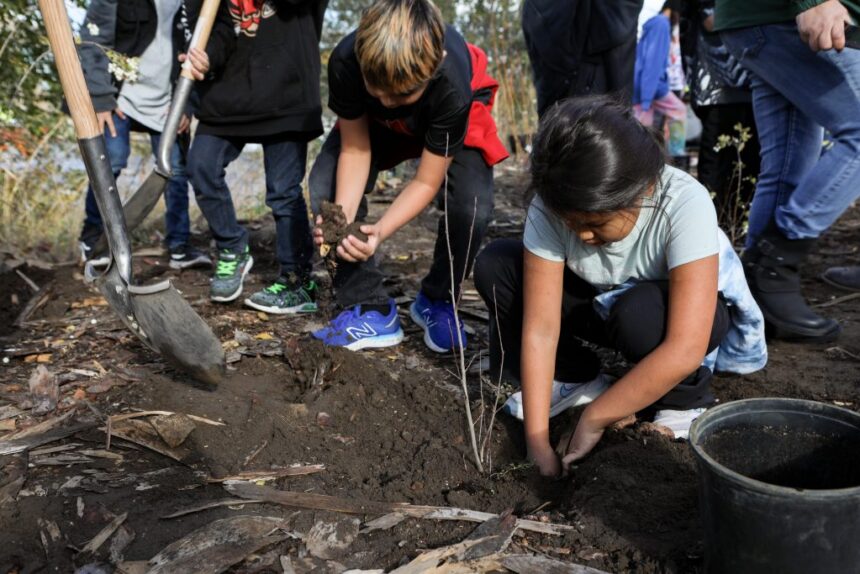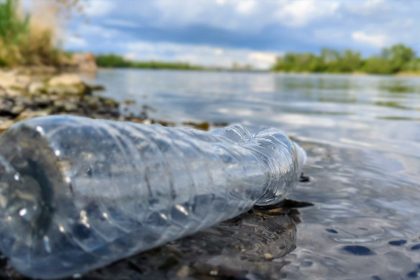Elementary students in sn’pink’tn plant native shrubs and trees as part of an effort to help migrating salmon In sn’pink’tn (Penticton), elementary students from Outma Sqilx’w Cultural School plant trees and shrubs near a fish passage site by Okanagan Lake Dam on Nov. 7. Photo by Aaron Hemens As the morning sun beams down upon them, dozens of elementary students eagerly make their way from their bus to a large garden plot of soil by the banks of sq’awsitkʷ (the Okanagan River). Waiting for the group from Outma Sqilx’w Cultural School are shrubs native to syilx homelands — snowberry, chokecherry, saskatoon berry, and wild roses — and trees including willow. The seedlings, still in their infancy, are ready to be planted with the help of the children’s hands and enthusiasm. “We’re going to save the world! We’re going to save the world!” one student enthusiastically proclaims as they stride along. And with the guidance of adults — who had brushed the seedlings’ roots with mycorrhizal fungi or bone meal fertilizer to help support their growth — the students get to digging and planting. Just steps away, the river roars past. The vegetation will not only grow to provide shade and help keep the water cool for future salmon migrating through the passage site, but it’ll also create habitat for different animals, too — birds, rodents and bugs, to name a few. Changed landscape, restored ecosystem The community-planting event was a day-two effort that began on Nov. 7. Participants planted roughly 500 native species into the land around the dam’s fish passage channel, which opened in August. Elementary students from Outma Sqilx’w Cultural School peer below the Okanagan Lake Dam, towards a fish passage entrance along sq’awsitkʷ (Okanagan River), in sn’pink’tn (Penticton) on Nov. 7. Photo by Aaron Hemens At this point the waterway diverts into two channels — the main vein going straight through the Okanagan Lake Dam in sn’pink’tn (Penticton), and a smaller flow bypassing the dam into kɬúsx̌nítkʷ (Okanagan Lake) through the fish passage. The Okanagan Nation Alliance (ONA) and several partners built the fish passage around the dam earlier this year to support returning salmon as they migrate to the upstream side of the dam, hoping to spawn in waterways connected to the lake. Facing east towards the Okanagan Lake Dam in sn’pink’tn (Penticton) on Nov. 7, with the fish passage entrance along sq’awsitkʷ (the Okanagan River) located to the centre-right of the image. Photo by Aaron Hemens “In 10 years, it’ll be an absolutely changed landscape,” said Lee McFadyen, an environmental advocate who helped organize the event with ONA’s fisheries team. “It will have a changed feel to it — it will become an ecosystem unto itself.” Community members plant trees and shrubs in the land surrounding the fish passage site at Okanagan Lake Dam in sn’pink’tn (Penticton) on Nov. 7. Photo by Aaron Hemens For decades, salmon were blocked from moving upriver into the lake because of the dam and channelization — an engineering process to straighten a winding waterway. For thousands of years before settler colonialism, the fish swam freely into kɬúsx̌nítkʷ and its creeks. McFadyen said this fall season’s salmon run saw the first sockeye in decades return to the lake. “The first time since the 1920s,” she said, proudly. A community member’s drawing of the fish passage site at Okanagan Dam in sn’pink’tn (Penticton) is displayed at the dam on Nov. 7. Photo by Aaron Hemens To build the fish passage channel, some trees had to be removed, disturbing soil in the area. McFadyen said part of ONA’s philosophy is to plant native species when soil is disturbed by a project. ‘Food for the future for so many species’ The group from Outma Sqilx’w Cultural School were among the 115 other students across four schools in the region who took part in the planting event’s first day. Additionally, roughly 100 adults joined the planting, too, as well as community youth groups including Penticton Scouts and Venturers. Elementary students from Outma Sqilx’w Cultural School prepare to plant trees and shrubs in the land surrounding the fish passage site at Okanagan Lake Dam in sn’pink’tn (Penticton) on Nov. 7. Photo by Aaron Hemens “What I really love about it is the collaborative effort — the coming together of communities. That is so important,” said McFadyen. “If we all don’t work together, we’re not going to make it.” Community members plant trees and shrubs in the land surrounding the fish passage site at Okanagan Lake Dam in sn’pink’tn (Penticton) on Nov. 7. Photo by Aaron Hemens Community members plant trees and shrubs in the land around a fish passage channel at the Okanagan Lake Dam in sn’pink’tn (Penticton) on Nov. 7. Photo by Aaron Hemens She said it was wonderful to have syilx kids there, whose ancestral relationship with salmon “has been so much part of their history.” Being out on the land and learning gives the children “a sense of place, a sense of time, a sense of pride and a sense of belonging,” she added. “One of the things that they might take away — and I hope that they do — is a pride of place, and a reconnection with their past. But moving forward with it.” Empty plant pots are stacked around the fish passage site at Okanagan Lake Dam in sn’pink’tn (Penticton) during a community planting event on Nov. 7. Photo by Aaron Hemens She called the planting event “a historical moment” for everyone involved. “It is righting a wrong,” she said. “It is food for the future for so many species and communities.” Lee McFadyen, an environmental advocate who helped organize the community planting event with Okanagan Nation Alliance’s (ONA) fisheries team, interacts with elementary students from Outma Sqilx’w Cultural School at the fish passage site at Okanagan Lake Dam in sn’pink’tn (Penticton) on Nov. 7. Photo by Aaron Hemens ‘Authentic to who we are as a people‘ nx̌əx̌sítatkʷ Shayla Allison, a culture and language teacher at Outma Sqilx’w Cultural School, accompanied three of her grade school classes to the planting event. She said that the land-based learning activities that her classrooms engage in — from planting and harvesting, to visiting hunting camps — are “authentic to who we are as a people.” Recently planted trees and shrubs at the fish passage site at Okanagan Lake Dam in sn’pink’tn (Penticton) on Nov. 7. Photo by Aaron Hemens “Before there were Western systems, schools and classrooms, our children have always learned … by being, connecting, learning and being intimate with the connections around you, like life and land,” Allison said. “That’s how we survived and lived. We knew about the science of plants; ecosystems; habitat — everything. The ways that we learned came from those ways of connecting with people and places.” Every week, she said, they go out on the land and learn. “Just connecting with the land. Also making sure that we’re respectful to the land, and leaving it better than it was when we got here,” she said. “The way I always try to look at it, is wanting these kids to not learn from a book. Or learn that science is from a Western construct, or done and taught in Western old school ways of sitting in a class.” nx̌əx̌sítatkʷ Shayla Allison, a culture and language teacher at Outma Sqilx’w Cultural School, assists her elementary students with planting efforts at the fish passage site at Okanagan Lake Dam in sn’pink’tn (Penticton) on Nov. 7. Photo by Aaron Hemens The beauty is seeing young people with learning or social challenges “thrive in that outdoor environment” and become “whole new kids.” “They get out, they’re the ones that are digging in the land — they’re smiling and they’re helpful. You see a new person,” she said. “You see the value of taking them out, and seeing them be less sensored and scared or afraid of being wrong. There is no wrong.” Elementary students from Outma Sqilx’w Cultural School prepare to plant trees and shrubs in the land surrounding the fish passage site at Okanagan Lake Dam in sn’pink’tn (Penticton) on Nov. 7. Photo by Aaron Hemens Whatever teachings they learn on the land are then brought back to the classroom, where they then “solidify what they learned and how they learned it,” Allison said. “Everyday, they learn how — one, they’re sacred as being children — but also, they can do good things and be helpful, even with learning. Your energy, your prayers and your thoughts go into everything that you do,” she said. “They learn, each time, about coming with good intentions and good feelings, being helpful.” Coming in with good intentions enables them to be mindful of where they are and who they’re with, she said. “We’re all here to learn. We may make mistakes, but we make sure to come with good intentions and heart,” she said. “It teaches them to be more observant and seeing — seeing the natural world and the people.” There’s no better place to educate children “than getting out and doing things” through experiential learning, she concluded — “finding a way to connect everything to what we’ve already always known — to be authentic in sqilx’w and Indigenous teachings wherever you can.” Elementary students from Outma Sqilx’w Cultural School peer down to sq’awsitkʷ (the Okanagan River), from the Okanagan Lake Dam in sn’pink’tn (Penticton) on Nov. 7. Photo by Aaron Hemens
Wednesday, 19 Nov 2025
Canada – The Illusion
Search
Have an existing account?
Sign In
© 2022 Foxiz News Network. Ruby Design Company. All Rights Reserved.
You May also Like
- More News:
- history
- Standing Bear Network
- John Gonzalez
- ᐊᔭᐦᑊ ayahp — It happened
- Creation
- Beneath the Water
- Olympic gold medal
- Jim Thorpe
- type O blood
- the bringer of life
- Raven
- Wás’agi
- NoiseCat
- 'Sugarcane'
- The rivers still sing
- ᑲᓂᐸᐏᐟ ᒪᐢᑿ
- ᐅᑳᐤ okâw — We remember
- ᐊᓂᓈᐯᐃᐧᐣ aninâpêwin — Truth
- This is what it means to be human.
- Nokoma











